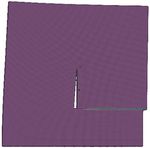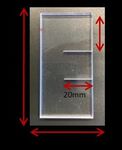Crack arrest and propagation in impact loaded shock resistant PMMA: mesh-free numerical simulation
←
→
Page content transcription
If your browser does not render page correctly, please read the page content below
EPJ Web of Conferences 250, 02021 (2021) https://doi.org/10.1051/epjconf/202125002021
DYMAT 2021
Crack arrest and propagation in impact loaded
shock resistant PMMA: mesh-free numerical
simulation
Kean-Sheng Tan1, Patrice Longère2*, and Norazrina Mat-Jali1
1
Faculty of Engineering, National Defence University of Malaysia, 57000 Kuala Lumpur, Malaysia
2
Institut Clément Ader, Université de Toulouse, ISAE-SUPAERO, MINES ALBI, UPS, INSA,
CNRS, 31400 Toulouse, France
Abstract. The use of shock resistant RT-PMMA in engineering structures
potentially subject to accidental overloading requires an evaluation of its
crack arrest capability under impact loading. Based on experimental results
obtained from a series of Kalthoff and Winkler (KW)-type impact tests, the
present study aims at numerically reproducing the conditions for brittle-
like crack initiation and propagation in impact-loaded RT-PMMA. For that
purpose, three-dimensional SPH numerical simulations were conducted
and the performance of various failure criteria was evaluated. The
numerical model together with a combination of stress- and strain-
dependent failure criteria were shown to fairly reproduce the experimental
results in terms of finite crack advance and orientation.
1 Introduction
A way of improving the poor impact resistance of PMMA consists in embedding rubber
nano-particles inside a PMMA matrix to form the so-called rubber toughened PMMA or
RT-PMMA, see [1]. The use of shock resistant RT-PMMA in engineering structures, as
f.ex. protection window, requires an evaluation of its crack arrest capability under impact
loading. For that purpose, a series of Kalthoff and Winkler (KW)-type impact tests [2-3]
has been carried on several grades of RT-PMMA evidencing the role of the rubber nano-
particles concentration, see [4,5]: the higher the nano-particles concentration the higher the
resistance to crack propagation.
Based on these tests, the present study aims at numerically reproducing the conditions
for brittle-like crack initiation and propagation in impact-loaded pre-cracked RT-PMMA. A
particular attention is paid to reproduce the crack arrest, in terms of finite crack advance
and orientation, which is far from being trivial and accordingly rarely addressed in
literature.
As an alternative to standard finite element method (FEM)-based numerical simulations,
see [6-8], known to involve unavoidable mesh-dependent crack path, the smooth particle
hydrodynamics (SPH)-based method was preferred here, see [9]. Various stress- and strain-
controlled failure criteria were evaluated regarding their performances to reproduce the
* Corresponding author: patrice.longere@isae.fr
© The Authors, published by EDP Sciences. This is an open access article distributed under the terms of the Creative Commons
Attribution License 4.0 (http://creativecommons.org/licenses/by/4.0/).EPJ Web of Conferences 250, 02021 (2021) https://doi.org/10.1051/epjconf/202125002021
DYMAT 2021
dependence of the finite crack advance and orientation on impact velocity as observed
experimentally. A parametric study was then achieved to calibrate the adopted failure
criterion.
Some experimental results are recalled in Section 2 and the numerical procedure is
detailed in Section 3. The results obtained with the adopted failure criterion are shown and
commented in Section 4. Concluding remarks are finally given in Section 5.
2 Experimental results
KW-impact tests consist in impacting the edge of a doubly-notched plate made of the
material of interest with a cylindrical projectile. Depending on the plate material and impact
velocity magnitude, cracks may initiate at the notches tips with a kink angle of +/- 70° wrt
to the notch plane (brittle fracture), see e.g. [2], or in a self-similar way (ductile fracture
under adiabatic shear banding), see e.g. [3].
A series of KW-type impact tests were carried out on a class of RT-PMMA at various
impact velocities at ICA Lab. using the STIMPACT facility equipped with three single-
stage gas guns. The 40mm-diameter gas gun was used. The KW-type specimen and the
sub-calibrated projectile with its guide (sabot) are shown in Fig.1. The plate/projectile
interaction was video-recorded at 100kfps using a high-speed camera, see an example of
picture in Fig.2a.
The tests showed that the cracks initiated from the notches tips with an angle of +/- 70°
wrt to the notch plane, see Fig.2 (and Fig.3a), as expected for a semi-brittle material, and
that the higher the impact velocity the larger the number of fragments. Moreover, within the
impact velocity range [20m/s;40m/s], cracks initiated from the notches tips are seen to
arrest inside the specimen, with a crack advance depending on the impact velocity, see
Fig.2.
a) KW-type doubly-notched specimen b) Sub-calibrated projectile and its sabot
Fig. 1. KW-type specimen and projectile used for the KW-type impact tests. After [5]
3 Numerical procedure
Numerical simulations were conducted using the industrial computation code LS-DYNA
employing the three-dimensional SPH-based spatial discretization and the explicit time
integration scheme.
2EPJ Web of Conferences 250, 02021 (2021) https://doi.org/10.1051/epjconf/202125002021
DYMAT 2021
Fig. 2. Experimental results after impact velocity of 25m/s (left) and 30m/s (right). Evidence of crack
arrest inside the plate. After [5]
In order to be as close to the experimental conditions as possible, all the parts
interacting during the impact were modeled. Both RT-PMMA doubly-notched plate and
steel sub-calibrated projectile were discretized using particles (SPH), and the polyethylene
foam projectile guide (sabot) using finite elements, see Fig.3b.
a) Experimental test. After [5] b) Numerical model
Fig. 3. Experimental configuration and numerical model.
The rate- and temperature-dependence of the RT-PMMA behavior was described using
tabulated curves coming from [5], as were the steel and foam behaviors. Self-heating was
accounted for by considering a Taylor-Quinney coefficient of 1.
To palliate the pathological SPH issue related to tensile instability and account for small
to moderate deformation, the regularised Lagrangian approximation was used. The
penetration was minimised thanks to the combination of the SPH contact condition and
time scale factor.
4 Numerical results
The performances of stress- and strain-dependent failure criteria regarding their ability to
reproduce the overall crack pattern and arrest were investigated, by first considering each
criterion individually, and by then combining them.
3EPJ Web of Conferences 250, 02021 (2021) https://doi.org/10.1051/epjconf/202125002021
DYMAT 2021
4.1 Stress- vs strain-dependent failure criterion
Failure criteria for brittle materials are generally expressed in terms of critical maximum
principal stress (CMPS), see [9]. For the RT-PMMA under consideration, the maximum
principal stress corresponding to a crack initiation at an impact velocity near 20m/s is close
to 103MPa. This value has accordingly been taken as CMPS. Corresponding numerical
simulations at the impact velocities 25m/s and 30m/s are shown in Fig.4. According to the
latter, the cracks initiate from the notches tips with the expected angle +/- 70° but cross the
whole plate. In other words, the crack orientation is well reproduced whereas the crack
arrest is not.
a) 25m/s b) 30m/s
Fig. 4. Numerical simulations. Maximum principal tress-dependent failure criterion. CMPS=103MPa.
To be compared with Fig.2.
In parallel, failure criteria for ductile materials are generally expressed in terms of
critical equivalent plastic strain (CEPS), see [6]. For the RT-PMMA under consideration,
the equivalent plastic strain corresponding to a crack initiation at an impact velocity near
20m/s is close to 2.9x10-2. This value has accordingly been taken as CEPS. Corresponding
numerical simulations at the impact velocities 25m/s and 30m/s are shown in Fig.5.
According to the latter, the cracks initiate from the notches tips with the expected angle +/-
70° then arrest inside the plate, while unexpected cracks propagate downwards in the
middle of the plate (see Fig.5b). In other words, the crack orientation and arrest are well
reproduced whereas other cracks form.
a) 25m/s b) 30m/s (middle of the plate)
Fig. 5. Numerical simulations. Equivalent plastic strain-dependent failure criterion. CEPS=2.9x10-2.
To be compared with Fig.2.
4EPJ Web of Conferences 250, 02021 (2021) https://doi.org/10.1051/epjconf/202125002021
DYMAT 2021
As above shown, the use of stress- and strain-dependent failure criteria individually fails
to reproduce the real crack conditions and pattern in the RT-PMMA of interest under
impact loading.
4.2 A combination of stress- and strain-dependent failure criteria
The objective is here to evaluate a failure criterion according to which failure occurs if and
only both CMPS and CEPS are reached. Following a design of experiment, a parametric
study was conducted to find the best set of (CMPS, CEPS) pair leading to the values
reported in Table 1.
Table 1. Best set of (CMPS,CEPS) pair for the RT-PMMA under consideration.
CMPS (MPa) 115
CEPS 5x10-2
Three-dimensional numerical simulations conducted with the set of (CMPS, CEPS)
pair in Table 1 are shown in Fig.6. When compared with Fig.2, one can conclude that the
numerical finite crack advance and orientation and overall crack pattern match fairly the
experimental ones.
a) 25m/s b) 30m/s
Fig. 6. Numerical results after impact velocity of 25m/s (left) and 30m/s (right). To be compared with
Fig.2.
5 Concluding remarks
In order to reproduce the experimental conditions for crack propagation and arrest in
impact-loaded pre-cracked shock-resistant RT-PMMA, a three-dimensional SPH-based
model was built, alleviating the well-known SPH tensile instability issue and accounting for
the rate- and temperature-dependent nature of the material of interest. It was shown that the
use of stress- and strain-dependent failure criteria individually fails to reproduce the real
crack conditions and pattern in the semi-brittle RT-PMMA of interest. By contrast, the
finite crack advance and orientation and the overall crack pattern can be fairly reproduced
by combining the above mentioned criteria.
This numerical methodology can be applied to a wide range of semi-brittle polymers
exhibiting crack arrest under impact loading.
5EPJ Web of Conferences 250, 02021 (2021) https://doi.org/10.1051/epjconf/202125002021
DYMAT 2021
References
1. J. Wang, X. Zhang, L. Jiang, J. Qiao, Advances in toughened polymer materials by
structured rubberparticles, Progress Polymer Sci., 98 (2019)
2. J.F. Kalthoff, S.Winkler, Failure mode transition of high rates of shear loading, in:
C.Y. Chiem, H,-D. Kunze, L.W. Meyer (Eds), Proceedings of the International
Conference on Impact Loading and Dynamic Behavior of Materials, Deutsche
Gesellschaft fur Metallkunde, DGM-Verlag, Oberursel, Germany (1987)
3. E. Roux, P. Longère, O. Cherrier, T. Millot, D. Capdeville, and J. Petit, Analysis of
ASB assisted failure in a high strength steel under high loading rate, Mater. Des., 75
(2015)
4. G. Manar, N. Mat Jali, P. Longère, Dynamic crack arrest capability of some metallic
alloys and polymers, Proceedings of DYMAT 2018 Arcachon, EPJ Web of Conferences
183, (2018)
5. N. Mat Jali, N.M. and Longère, P., Experimental investigation of the dynamic fracture
of a class of RT-PMMAs under impact loading, Int. J. Fracture, 225 (2020)
6. M. Zhou, AJ Rosakis, G. Ravichandran , Dynamically propagating shear bands in
impact-loaded prenotched plates-II. numerical simulations, Journal of the Mechanics
and Physics of Solids, 44 (1996)
7. RC. Batra, MVS. Ravinsankar. Three-dimensional numerical simulation of the Kalthoff
experiment, Int. J. Fracture, 105 (2000)
8. K. Ravi-Chandar, J. Lu, B. Yang, Z. Zhu . Failure mode transitions in polymers under
high strain rate loading, Int. J. Fract, 101 (2000)
9. S. Raymond, V. Lemiale, R. Ibrahim, R. Lau. A mesh free study of the Kalthoff-
Winkler experiment in 3D at room and low temperatures under dynamic loading using
viscoplastic modelling, Engineering Analysis with Boundary Elements, 42 (2014)
6You can also read



























































